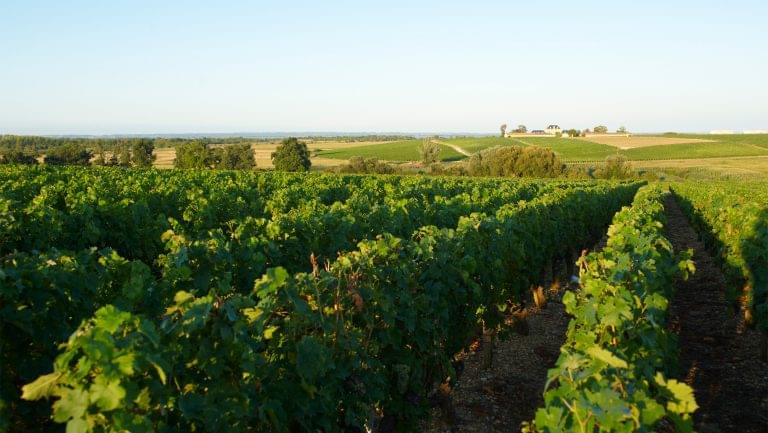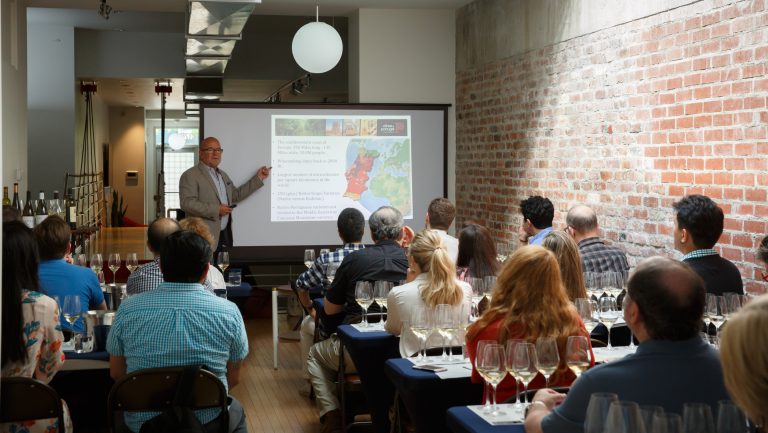This advertising content was produced in collaboration with our partner, Les Vins du Médoc.
It’s difficult to name a wine region that is better known and more influential than the Médoc in Bordeaux. From the tradition of crafting and blending benchmark Cabernet Sauvignon and Merlot, to the international acclaim of the legendary 1855 Classification, to the practice of barrique-aging wines that would last for decades, the Médoc’s global and historical impact is hard to quantify.
“How has the Médoc not influenced wine?” says Amber Rill, the assistant beverage director at Corkbuzz in New York City. “There is a reason wines the world over are made as a ‘Bordeaux blend.’”
Despite this unrivaled recognition, there is much that industry members still have to discover about the Médoc, its vineyards, and its wines. SevenFifty Daily spoke to retailers and sommeliers across the country to highlight some of the Médoc’s biggest misconceptions—and revelations.

Don’t miss the latest drinks industry news and insights. Sign up for our award-winning newsletters and get insider intel, resources, and trends delivered to your inbox every week.
The Médoc’s Terroir is Complex
Two of the first things young wine enthusiasts learn about the Médoc is that it has gravel soils and is dominated with Cabernet Sauvignon plantings. While this isn’t untrue, the region’s vineyards are more complex than that—and they didn’t start off that way.
“It is actually the best example of man-made terroir,” says Aviram Turgeman, the beverage director for Nice Matin and Chef Driven Group in New York City. “The Dutch drained the swamps in the mid-17th century and set the ground for well-drained, gravelly soils that are so suitable for ripening Cabernet Sauvignon in Bordeaux’s maritime climate.” Once the Médoc peninsula was no longer underwater, vintners spent the subsequent centuries meticulously studying the region’s terroir and matching the right grape varieties to soil types.
“The general public shouldn’t be distracted by the glitz and glamor to forget that ultimately what the Médoc does best is what is situated in the vineyards,” says Hai Tran, a Philadelphia-based sommelier who has crafted beverage programs at many top restaurants.
In fact, gravel is not the whole story: there’s plenty of clay-limestone soil situated between strips of gravel toward the east and west of the peninsula, meaning nearly half of the Médoc’s vineyards are planted to Merlot. This creates surprising stylistic diversity and approachability. Plus, Merlot’s inclusion in blends allows for fruitier wines that can be enjoyed young.
Innovation is Integral to Médoc Culture
The Médoc hasn’t just been a standard-bearer for the quality of its wines. Throughout its history, the Médoc has been the genesis of new practices and technologies, many of which have been adopted throughout the world. “The Médoc has been a place of innovation since its inception,” says Jacob Brown, a sommelier at Lazy Bear in San Francisco, pointing out the region’s proximity to the University of Bordeaux and wine greats like Émile Peynaud.
Even concepts that seem simple now, like excluding rotten or under-ripe grapes from vinification, or fermenting wine in batches based on vine age, and aging wines in small oak barrels, were pioneered in the Médoc. Today, the Médoc is quick to research and adopt new practices.
“Médoc producers tend to be trendsetters when it comes to using wine technology,” says Erik Segelbaum, the founder and chief vinnovation officer at SOMLYAY in Washington, D.C. He recalls visiting the Médoc several years ago, and when the rest of the world was marveling over optical grape sorters, Médoc producers had already adopted the latest density sorting technology.
Sustainability is a Priority
“The winemakers of the Médoc, at all levels, have committed to sustainability in a big way,” says Brown. Despite the challenges of viticulture in the Médoc’s wet climate, centuries-old legends and enthusiastic up-and-comers alike are working sustainably or utilizing organic or biodynamic practices. In 2017, 60 percent of all Bordeaux vineyards were certified by an environmental process, but the region aims for that number to reach 100 percent soon.
“Overall, most estates are choosing to work in a more integrated way, treating problems as they arise and not systemically,” says Rill. In order to achieve their sustainability goals, Médoc producers are working together to reduce pesticide use, research extensively in order to plan for the future, prioritize biodiversity, and minimize the region’s carbon footprint. “To see top estates lead by example and take risks in the vineyard to ensure the ability to grow wines for many generations is inspiring,” says Brown.
There Are Many Undiscovered Châteaus
Though it’s 165 years old, some consumers and trade members solely associate the Médoc with the classified growths included in the 1855 Classification. But these châteaus represent less than a quarter of the Médoc’s vineyards. “As one can imagine, a lot can and has changed since 1855,” notes Tran, “including the rise of new properties that have not been considered for this classification.”
“Many estates have also purchased or swapped land with more prestigious châteaus,” adds Rill, “or have vineyards that abut the vines of the more famous names.” She says that one of the biggest misconceptions about the Médoc is the notion that wines not included in the 1855 Classification are of inferior quality. “There have been many classifications since [then] highlighting estates of exceptional quality,” she notes.
The Cru Artisan designation, for instance, represents estates that control their production from vineyard to bottle and are recognized for their commitments to quality, while the Cru Bourgeois classification was recently redesigned to include three tiers of estates who could apply the classification to their labels beginning with the 2018 vintage. “I believe this will be an advantage to consumers and trade attempting to understand Médoc wines,” says Rill. “Because an estate only retains its ranking for five years, it ensures continued quality and consistency from the estate to keep the status.”
But a Médoc wine need not have an official classification to produce high-quality wines. “There are many unclassified châteaus that are producing delicious wines you can get for $15 a bottle,” says Segelbaum.

Communal and Regional AOCs Offer Great Value
While the Médoc is largely associated with expensive, cellar-worthy wines, there is plenty of value to be found in these vineyards. Though the price tags for first growths might break records, most Médoc wines fall within the $15 to $30 range without sacrificing quality. “I can’t remember tasting a Médoc wine that was sub-par or a bad value,” says Madeline Triffon, MS, of Michigan’s Plum Market. “The quality of the wine is so high across the board.”
A good way to find value in the Médoc is by exploring its communal AOC wines. Because appellations like Pauillac and Margaux have the name recognition associated with top châteaus, steer off the beaten path to the region’s lesser-known communal AOCs. “Listrac and Moulis are historically centers for terrific value,” says Triffon, “and they have been way overdelivering for the last 10 to 15 years.” Many of these less expensive wines will be more approachable in youth as well, as they often use more Merlot and avoid new oak.
It isn’t just communal appellations that offer great value in the Médoc, though. “Don’t sleep on the Médoc AOC and Haut-Médoc AOCs as the overall quality of wines being produced have been elevated,” says Tran. “There is a reason why a large number of the Cru Bourgeois are coming from these areas.”
Second and Third Wines Are Getting Even Better
“In the past 10 years, second and third wines have become more accessible for new generations,” says Carrie Lyn Strong, the New York-based sommelier and owner of Strong Wine Consulting, LLC. Though second labels have been around since the mid-18th century, their overall quality has risen in recent years as châteaus work to protect the reputation of their grands vins. “The vast majority of top producers in Bordeaux make second labels that are a fraction of the price of their main label and are often much better in their youth,” says Brown.
The phenomenon of a château selling a third label is more recent, and it’s largely driven by increased occurrence of plentiful harvests with ripe, good-quality grapes. “Grapes that didn’t make it into the second label were previously sold off,” says Triffon, “but because of the high quality of grapes today, that’s not happening anymore. It’s a phenomenon that has benefited the consumer and buyer.”
New Generations Are Pushing the Médoc Forward
While the Médoc has a long history of tradition, today’s producers are challenging accepted practices and pushing boundaries to create a wider range of high-quality wines for international audiences. No longer is the Médoc vineyard defined solely by traditional, big-name estates and styles; now, there are more small, family-owned producers, more women in decision-making positions, and younger winemakers with forward-thinking mindsets.
“Though it is still rooted in tradition, the younger generation is open to new ideas and approaches,” says Rachael Lowe, the beverage director for Spiaggia in Chicago. Modern generations are changing traditional oak regimes, experimenting with eggs, amphorae, and concrete tanks, and keeping wines in tank or concrete for longer in order to emphasize fruit-forwardness.
“I believe that the Médoc is constantly evolving,” says Strong. “The future holds more approachable, earth-friendly, delicious wine.”

Dispatch
Sign up for our award-winning newsletter
Don’t miss the latest drinks industry news and insights—delivered to your inbox every week.









